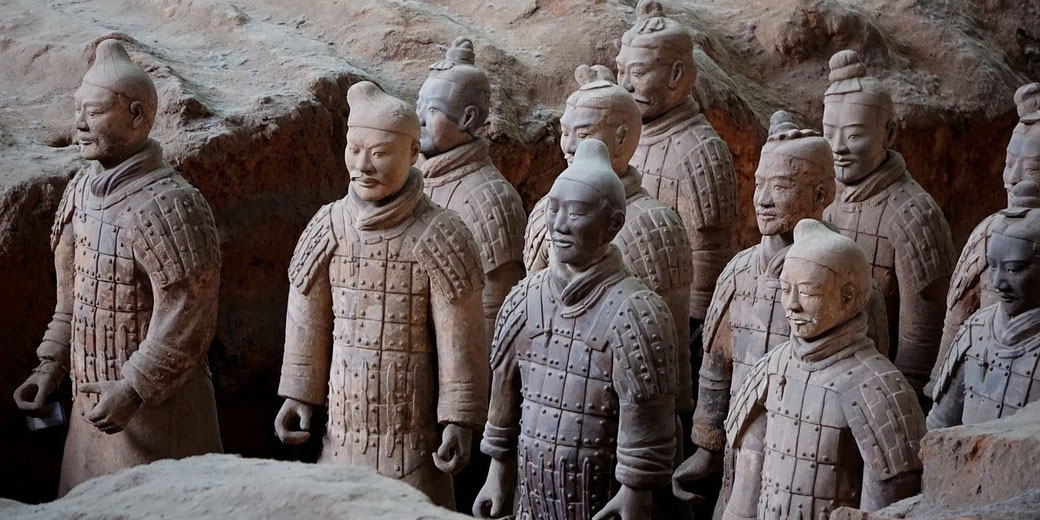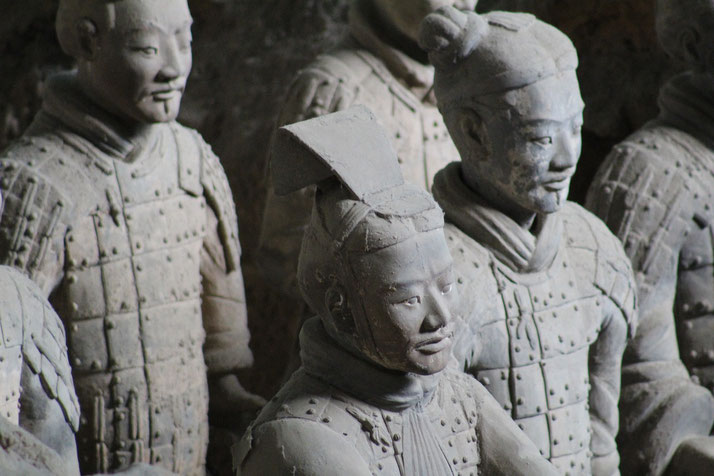Step back in time to ancient China, where a massive tomb complex was built for the first emperor, Qin Shi Huang. As you wander through the underground chambers, you stumble upon something unexpected: an army of life-size terracotta warriors, each one unique in its own way.
These figures, meticulously crafted over 2,000 years ago, stand in formation, ready for battle. You’re standing in the midst of the Terracotta Army, one of the greatest archaeological discoveries of our time.

But despite decades of research, the mysteries surrounding this incredible find continue to baffle and intrigue experts.
In this article, we delve into the enduring mystery of the Terracotta Warriors and the First Emperor’s Tomb, exploring the fascinating history, art, and culture of ancient China.
What was the Terracotta Army?
The Terracotta Army is one of the most famous archaeological discoveries in history.
Located near Xi’an in China, this collection of thousands of life-size terracotta figures represents the army that was buried with Qin Shi Huang, the first emperor of China, over 2,000 years ago.
The discovery of the Terracotta Army has provided invaluable insight into the art, culture, and history of ancient China.
However, despite decades of research, there are still many unanswered questions about this enduring mystery.
Their discovery
The Terracotta Army was discovered by a group of farmers who were digging a well in 1974.
They unearthed several clay fragments, which turned out to be parts of a terracotta warrior.
The news of this discovery quickly spread, and archaeologists were soon excavating the site.
They found a massive underground tomb complex, covering an area of 20 square miles, which was believed to be the final resting place of Emperor Qin Shi Huang.
 Source: https://pixabay.com/photos/terracotta-warriors-warrior-soldier-16860/
Source: https://pixabay.com/photos/terracotta-warriors-warrior-soldier-16860/
Who was Qin Shi Huang?
Shi Huangdi, also known as Qin Shi Huang, was the first emperor of China. He ruled from 221 BC to 210 BC, during a period known as the Qin dynasty.
Shi Huangdi was a powerful and ambitious ruler who conquered and unified the various warring states of China, thereby creating a unified Chinese empire for the first time in history.
He is also credited with implementing major administrative, economic, and social reforms, such as standardizing weights and measures, building roads and canals, and establishing a centralized government system.
However, his legacy is also controversial, as he was known for his harsh rule and brutal treatment of his enemies, as well as his suppression of intellectual and cultural expression.
The strange burial of the warriors
The Terracotta Army was found in three large pits, each containing thousands of terracotta figures, arranged in battle formation.
The figures were highly detailed, with individualized facial features and hairstyles, and were equipped with weapons and armor.
It is estimated that there are over 8,000 figures in total, including soldiers, chariots, and horses.
The discovery of the Terracotta Army has shed light on the incredible artistic and engineering skills of the ancient Chinese.
The figures were made using a complex production process that involved molding, firing, and painting.
It is believed that over 700,000 laborers worked on the tomb complex over a period of 37 years, from 246 BC until the emperor’s death in 210 BC.
 Source: https://pixabay.com/photos/china-statues-warriors-terracotta-4366989/
Source: https://pixabay.com/photos/china-statues-warriors-terracotta-4366989/
Unanswered questions…
Despite the wealth of information provided by the Terracotta Army, there are still many unanswered questions about the tomb complex and the emperor’s burial.
One of the most pressing questions is why the emperor chose to be buried with such a vast army of terracotta figures.
Some experts believe that the Terracotta Army was meant to protect the emperor in the afterlife, while others speculate that it was meant to showcase the emperor’s military might and power.
Another mystery surrounding the tomb complex is the identity of the people who created the Terracotta Army.
Although the workers who built the tomb complex were likely slaves or prisoners of war, the artisans who created the figures were likely skilled craftsmen.
However, no records of the artisans who created the Terracotta Army have been found, and their identities remain a mystery.
 Source: https://pixabay.com/photos/terracotta-army-terracotta-warriors-2967852/
Source: https://pixabay.com/photos/terracotta-army-terracotta-warriors-2967852/
The lethal dangers of the tomb
One of the most intriguing mysteries surrounding the Terracotta Army is the emperor’s tomb itself.
Although the tomb complex has been extensively excavated, the emperor’s tomb has yet to be fully explored.
Experts believe that the tomb may contain a vast array of treasures and artifacts, as well as important historical records.
However, the Chinese government has been hesitant to excavate the tomb, citing concerns over the preservation of the site and the potential damage that could be caused by excavation.
In 2012, Chinese archaeologists conducted extensive tests on the tomb complex, including scanning it with advanced imaging technology.
They discovered elevated levels of mercury in the soil surrounding the tomb, leading some to believe that the emperor’s tomb may indeed contain rivers of liquid mercury.
However, there is currently no direct evidence of this, as the tomb has not been fully excavated due to concerns over preservation and potential damage.
While the potential use of mercury in the tomb is fascinating, it also raises concerns about the environmental and health impacts of such a discovery.
Liquid mercury is a highly toxic substance that can have serious health effects if not handled properly, and any excavation of the tomb would need to be conducted with extreme caution and care.
Until the tomb is fully explored, the potential use of mercury in the Terracotta Army and the First Emperor’s tomb remains a tantalizing mystery.
The ongoing mystery
Despite the many mysteries surrounding the Terracotta Army and the emperor’s tomb, the discovery remains one of the most significant archaeological finds in history.
The Terracotta Army has provided us with valuable insights into the art, culture, and history of ancient China, and has inspired countless researchers and scholars around the world.
As we continue to explore this enduring mystery, we may one day uncover the secrets of the first emperor’s tomb and the incredible civilization that created it.






